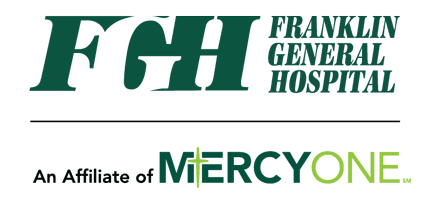Radiology
FGH Radiology Services are available to patients, based on referrals, Monday through Friday, 8 a.m. to 4:30 p.m. Emergency coverage is provided 24 hours a day. Remember, even if you have to see a specialist at a larger facility, you can request testing be done at Franklin General Hospital, where you will have shorter wait times, more personalized service and high quality care.
Services:
CT Scanning

The Computed Tomography Scanner (CT Scanner) is a special X-ray machine that uses computer techniques to produce images of your body. The CT scanner is shaped like a doughnut and the X-ray machine moves around your body while you lie on the table. During the scan, an IV may be started for the injection of the intravenous (IV) contrast solution to better visualize the vessels and structures of the body part being imaged. The ordering physician will be able to inform you if the IV contrast solution is needed.
DEXA Scanning
Dual Energy X-ray Absorpitometry, uses two energies; X-ray and an absorption energy, to obtain an image and measure the densities within the spine and hips. This gives the most accurate result in diagnosing osteoporosis risk.
Diagnostic Radiology
Diagnostic Imaging is a conventional X-ray. We have two diagnostic imaging rooms where we can perform all types of X-rays,
including digital fluoroscopy (live X-rays of the esophagus, stomach and bowels).
3D Mammography
Mammography is a specific type of imaging that uses a low-dose X-ray system to examine breasts. A mammography exam, called a mammogram, is used to aid in the early detection and diagnosis of breast diseases in women. 3D Mammography uses many image "slices" to create a 3D view of the breast tissue, providing for better visualization of abnormalities and earlier detection of breast cancers.
Magnetic Resonance Imaging (MRI)
MRI stands for Magnetic Resonance Imaging. This is a safe and dynamic way for doctors to see inside the body and diagnose certain diseases. MRI does not use X-rays. Instead, it uses a magnetic field and radio waves to create a very clear picture of structures inside your body. MRI uses sensitive equipment and specially-designed computers to create images of the entire area being scanned. There is no radiation involved, and the procedure should not cause you any pain.
Nuclear Medicine
Nuclear imaging is a method of producing images by detecting radiation from different parts of the body after a radioactive tracer material is administered. The images are recorded on computer and on film. The main difference between nuclear imaging and other radiologic tests is that nuclear imaging assesses how organs function, whereas other imaging methods assess anatomy or how the organs look. The nuclear imaging physician interprets the images to make a diagnosis.
Ultrasound
Ultrasound is the examination of internal organs through the use of high-frequency sound waves. Ultrasounds produce real-time images of soft tissue and can capture movement of internal organs. Therefore, ultrasound is used to visualize and diagnose problems inside the abdominal cavity.
Vascular Ultrasound
Vascular ultrasound refers to a noninvasive diagnostic procedure used to examine internal blood vessels. Vascular imaging may be used to evaluate the veins of the arms and legs, arteries of the arms and legs, carotid artery, aorta and its arterial branches, renal (kidney) arteries and hepatic (liver) arteries and veins. A physician may recommend a vascular ultrasound to evaluate signs and symptoms of a possible DVT (blood clot in the deep veins of the arms or legs), varicose veins, narrowing of the carotid artery, as well as other possible blockages from plaque.
Cardiovascular Ultrasound
Cardiovascular ultrasound is the examination of the heart and/or arteries and veins in the body using high-frequency sound waves.
Echocardiogram
An echocardiogram (echo) is an ultrasound of the heart, a test that uses ultrasound to examine and capture pictures of your heart while it is beating. It is safe and painless, and is used in diagnosing a variety of heart problems. Doppler is often performed during an echocardiogram to determine the direction and velocity of blood flow in your heart.
Imaging Manager
Meggan M. Cearley RT(R)(M)
Franklin General Hospital
641.456.5026
